
views
Soaking Up the Vomit
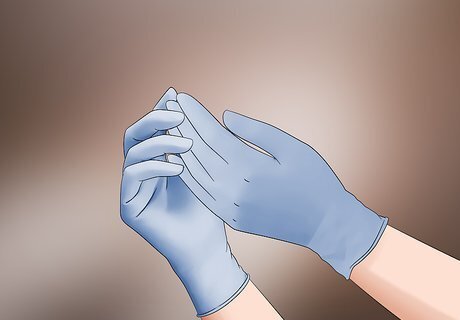
Safeguard yourself from germs. Before you get anywhere near the mess, you're going to want to make sure you're properly protected. Pull on a pair of thick rubber dish gloves and, if possible, wear something to cover your face. Try not to let any part of your body come into contact with the vomit. If you have a weak stomach, it might be a good idea to smear some menthol rub, peppermint oil or another strong fragrance under your nose. Keep small children and pets away from the mess until you've had time to treat it.

Scrape up the worst of the mess. Use a paper plate, sheet of cardboard or folded piece of newsprint to scoop up any thick chunks. Try to get up as much solid and semisolid material as you can. This will make the later stages of cleaning much easier. Make sure you have a trash bag nearby to dispose of the mess, along with the items you used to remove it. It's not recommended that you use a spatula, plastic scraper or other utensil unless you're prepared to throw it away afterwards. Take the trash out as soon as you're finished to minimize the danger of germs spreading.
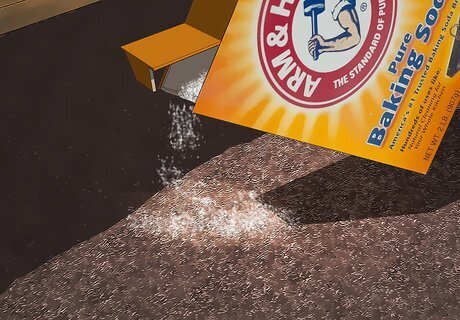
Sprinkle the affected area with an absorbent substance. Shake some baking soda, kitty litter or cornstarch onto the wet spot. Cover the entire area, being careful not to leave any of the mess exposed. Leave the powder in place for 15-20 minutes to soak up as much as vomit as possible. These materials are especially useful when treating vomit stains on carpet and upholstery, where messes have more spaces to hide. If you're unable to take care of the mess right away, you can skip the manual cleanup and go straight for the absorbent layer.
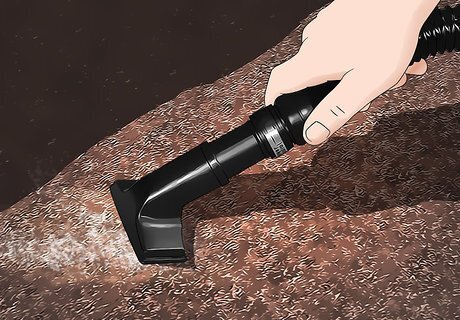
Vacuum up the remaining vomit. Once the powder has had a chance to dry, go over the spot several times using a high power setting. This should take care of most of the vomit itself. However, on textile surfaces there may still be staining and lingering odors to deal with. A brush or dusting attachment make it easier for the suction to reach deep down into carpet fibers. Give hard surfaces a once-over with a disinfecting wipe or a washcloth soaked in soapy water after vacuuming to finish the job. Don't forget to empty the vacuum of the dried mess when you're done (ideally in a separate trash bag).
Treating the Stain
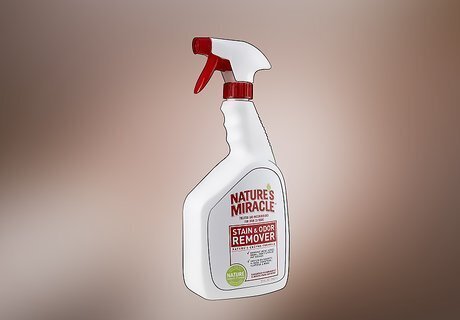
Buy or make a cleaning solution. Enzyme-based cleaners break down proteins, acids and bacteria, disinfecting and deodorizing in one. These can be found at most pharmacies, pet stores or janitorial supply outlets. You also have the option of mixing up your own cleaner using basic household items. A few of the most trusted brands of enzymatic cleaners include Simple Solution, Capture and Nature's Miracle. To make a basic cleaning solution at home, combine two cups of warm water, half a cup of distilled white vinegar, one tablespoon of clear liquid dish soap and two tablespoons of rubbing alcohol in a small bucket or spray bottle.
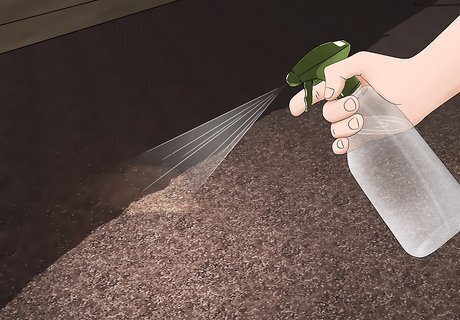
Apply the cleaner to the soiled surface. Spray the vomit stain liberally, including around the outer edges where germs may have begun spreading. Let the cleaner sit for about 5 minutes. It will begin to kill germs immediately. Assuming you're not using a spray bottle, dip a washcloth or sponge into the cleaning solution, wring out the excess and blot the area around the stain. Be careful not to oversaturate carpet or delicate upholstery. Too much moisture may damage certain materials or make it more likely for mold and mildew to develop.

Blot at the stain vigorously. Press the cloth or sponge into the spot to work in the disinfecting solution. Avoid scrubbing or wiping at first, as this can spread the stain to a larger area. As you work, rotate whatever tool you're using. Colorful stains are particularly tricky, and should be handled carefully to prevent them from getting out of hand. A single pass may be all that's needed to clear vomit from harder surfaces like tile, laminate, hardwood or metal.
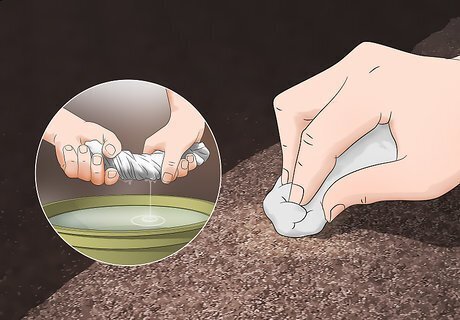
Repeat until the vomit is completely gone. Wring out the cloth or sponge and apply fresh cleaner. Continue dabbing at the stain until it disappears. You'll likely have to scrub more forcefully at this point to make sure every last trace of the mess comes out of the surface. It may take considerable time and effort to completely erase the stain, but be persistent. The longer you work at it, the better it will look. For vomit stains on clothing, follow the same steps, then throw the garment into the washing machine and wash it on a high temperature cycle as soon as possible. Launder all towels and washcloths that you used to spot-clean the mess. Used sponges should go straight into the trash.
Deodorizing the Area
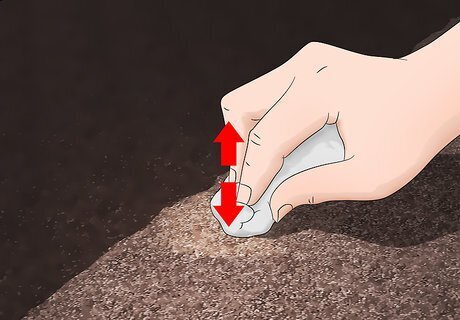
Dust the surface with baking soda. Cover the affected area while it's still damp so that the baking soda has an easier time sticking. If possible, place another object (like a bucket, bowl or plastic washtub) over the stain so that it's completely enclosed. That way, more of the odor will be trapped rather than escaping into the air. You should follow up with this step even if you used baking soda to soak up the vomit originally. A second application will most likely be needed to rid the area of more persistent odors.

Let the baking soda sit overnight. It will take several hours for the sodium bicarbonate to absorb the remainder of the odor-causing residue. In the meantime, there's not much else you can do but be patient. Wait until the baking soda has solidified into dry clumps before suctioning it up.
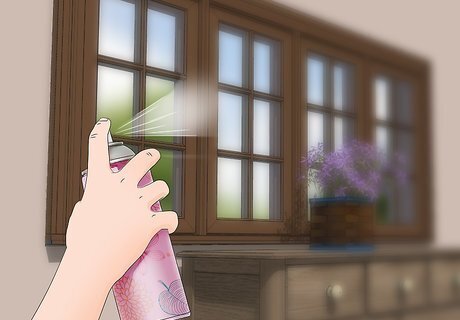
Air out the room. Spray the room with a powerful air freshener or a homemade version mixed from water, fresh citrus juice and essential oils. If possible, leave a door or window open to the room to promote ventilation. Most of the smell should dissipate within a couple of hours. Turning on the overhead fan or air conditioning can help cut down on overpowering odors. Avoid running the heater, which can thicken odors and make them more pronounced. Burning scented candles may also help improve the air quality in the room.
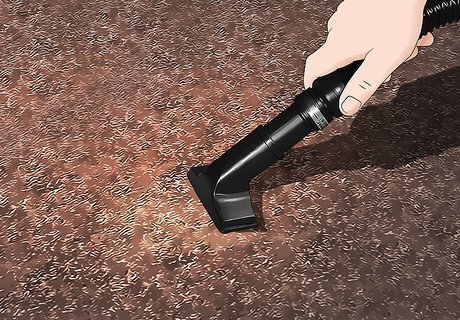
Vacuum up the dried mess. Sweep the area from multiple angles, using a variety of head attachments as needed. Run your hand over the spot to make sure you didn't miss any baking soda. After you've vacuumed a second time, it will be hard to tell there was ever a stain there in the first place. Use a handheld vacuum or Shop-Vac to remove baking soda from your car interior or other hard-to-reach spots. Be sure to empty out the contents of the vacuum into the trash to get rid of the clumps before using it again.















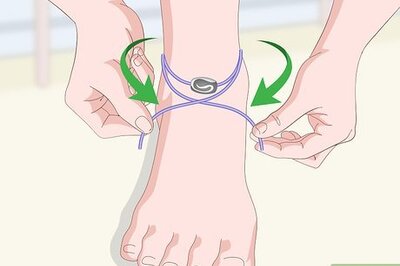



Comments
0 comment